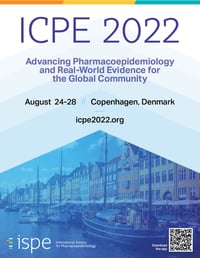Cytel Presents at ICPE 2022

The International Society for Pharmacoepidemiology is hosting its “ICPE 2022: Advancing Pharmacoepidemiology and Real-World Evidence for the Global Community” conference in Copenhagen, Denmark, this year. Cytel’s experts authored the following presentations:
Using Real-World Data to Examine Treatment Patterns of Patients with Advanced Non-Small Cell Lung Cancer Treated with Systemic Therapies
Cytel co-authors: Jason Simeone, Nicole Croteau, and Sabrina Mueller
Background:
Advanced non-small cell lung cancer (aNSCLC) is common. Currently, comprehensive real-world (RW) data are needed due to the rapidly changing treatment landscape.
Objectives:
Describe first- (1L), second- (2L), or third-line (3L) aNSCLC treatment regimens, time-to-treatment (TTT), and treatment duration.
Methods:
In this retrospective cohort study, 27,4691 U.S. patients (age ≥18 years) with an incident diagnosis of lung cancer (index date) between 01/2016–05/2021 were identified from Komodo healthcare claims data; 16,427 were classified as aNSCLC by metastatic diagnosis ≤1 month pre- and ≤3 months post-index and aNSCLC treatment ≤3 months post-index. Patients were followed until the earliest of health plan disenrollment or 11/2021. All patients had ≥6 months follow-up, no other primary malignant neoplasms, and no small-cell lung cancer-specific treatment. 1L treatment was defined as first systemic treatment after diagnosis excluding therapies ≤90 days of surgery. A line of therapy was defined as agents prescribed ≤30 days of starting the line. End of treatment line was assumed if gap in drug availability >45 days. Treatment duration was assessed with Kaplan-Meier statistics, including 95% confidence intervals (CI).
Results:
Median age was 63 years (range 18–89); 49% were male. Payer type (multiple were possible) included commercial (40.9%), Medicaid (18.6%), Medicare (27.6%), and other (33.3%). 16,122 (98.1%) received 1L systemic treatment, 7,251 (44.1%) 2L, and 2,090 (12.7%) 3L. Median follow-up was 14.7 months. Most common regimens by line included carboplatin + paclitaxel (1L: 25%), durvalumab (2L: 21%), and gemcitabine (3L: 12%). Immunotherapy was used in 60.8% of all patients (1L: 34.7%, 2L: 55.5%, 3L: 33.9%). Targeted therapies, including ALK- and EGFR-inhibitors, were used in 12.4% of patients (1L: 10.2%, 2L: 8.4%, 3L: 8.7%). Median TTT was 1.3 months. Median 1L duration was 2.14 months (95% CI 2.10–2.24), median 2.20 months (95% CI 2.07–2.30) for 2L, and median 1.64 months (95% CI 1.55–1.84) for 3L. 3.1% of patients received treatment beyond 3L.
Conclusions:
Platinum-based chemotherapy was the most common regimen in 1L, immunotherapy most common in 2L, and chemotherapy most common in 3L aNSCLC therapy. This study leverages a large claims database and results are consistent with other RW studies.
Did Publication Urgency During the Pandemic Trade Off for Epidemiological Rigorousness? Results from an Umbrella Review
Cytel co-authors: Grammati Sarri and Andreas Freitag
Background:
Scientific studies related to COVID-19 are pivotal for understanding patient characteristics, changing disease patterns, and treatment effectiveness and safety. During the pandemic, the urgent need for constantly updated evidence synthesis to inform public policy placed systematic reviews (SRs) at the center of COVID-19 research. However, the publication urgency from the scientific community appeared to trade off the epidemiological input capturing the data complexity, drivers, and impact of the pandemic.
Objectives:
We aimed to evaluate if previous SLRs on predictors of COVID-19 severity and disease progression have incorporated detailed epidemiological considerations in terms of appropriateness of study designs and impact of different types of biases.
Methods:
An umbrella review was conducted following PRISMA and Cochrane guidelines to systematically identify and summarize evidence from previously conducted SRs on predictors in COVID-19 outcomes. Several electronic databases were searched from 2020 onward with English-language restrictions. Dual data screening and extraction was guided by a pre-defined PROSPERO-registered protocol and each publication was assessed independently by two reviewers. Conflicts were resolved by a senior third reviewer. Results were synthesized qualitatively across the identified SRs.
Results:
Across databases, searches retrieved 4,564 publications. Abstract and full-text screening is ongoing; at 60% level completed, 20 SLRs were identified to investigate the role of single or multiple factors in COVID-19 progression. All SLRs followed clear search strategy with well-defined inclusion and exclusion criteria. Ninety percent of included studies in each SLR were quality assessed by established tools/ checklists but methodological considerations specific to COVID-19 disease in terms of study and outcomes definitions and biases linked to changing nature of pandemic were not consistently addressed (less than 50%). Although meta-analysis was performed in most SLRs, only a few of them used quality criteria to inform which studies could provide reliable results for a quantitative synthesis.
Conclusions:
Lack of assessment and consideration of potential flaws and biases within the included studies in SRs limits the validity of a review and the generalizability of its findings, thus compromising trust in evidence summaries. Extra caution should be applied when interpreting the results of SLRs published during pandemic.
If you’d like to know more about Cytel staff presentations, please contact us:





